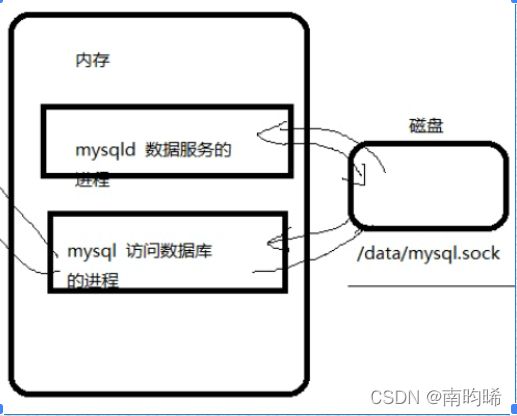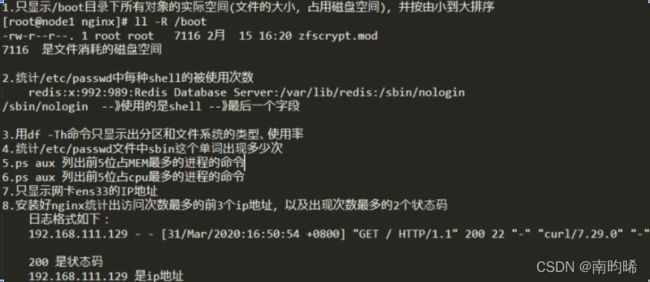【Linux】(16)文本处理命令:管道+awk+xargs+tr+sort+uniq+cut
目录
一、管道 |
1.1 管道的用处
1.2 【拓展】进程与进程之间的通信方式
1.2.1 管道 pipe
1.2.2 socket文件
1.3 【拓展】awk 截取
1.4 ; 命令连接符、
1.5 插入两个小练习
1.5.1
1.5.2
1.5.3 【知识补充】如何判断一个目录是否存在
1.5.4 在python中如何判断文件夹是否存在
1.6 xargs
二、文本处理命令
2.1 tr命令
2.1.1 tr命令的一个注意事项
2.1.2 替换文件里的某一些内容
2.1.3 选项(-d -s)
2.2 sort
2.2.1 默认情况
2.2.2 指定排序键 -k
2.2.3 指定分割符 -t
2.2.4 综合性例题
2.3 uniq
2.3.1 【例】搭建一个nginx的web服务器,统计访问次数最多的前3个ip地址
2.4 cut
2.4.1 常见选项
2.4.2 提取范围
三、插入一个练习
一、管道 |
将前面命令的输出送给后面的命令使用
1.1 管道的用处
默认情况下,管道只会将前面一个命令正确的输出送给后面一个命令作为输入。
[root@localhost 0325]# ip add | grep "inet"
inet 127.0.0.1/8 scope host lo
inet6 ::1/128 scope host
inet 192.168.255.132/24 brd 192.168.255.255 scope global noprefixroute dynamic ens33
inet6 fe80::5e3f:2e7b:4978:aa4e/64 scope link noprefixroute
[root@localhost 0325]# ip fdlihua | grep "fd"
Object "fdlihua" is unknown, try "ip help".
【实现将错误的输出也传给后面的命令】
grep 是一个文本过滤命令,根据字符串去匹配,只要这一行里含有这个字符串就会输出这一行。
[root@localhost 0325]# ip fdlihua 2>&1 | grep "fd"
Object "fdlihua" is unknown, try "ip help".
1.2 【拓展】进程与进程之间的通信方式
1.2.1 管道 pipe
默认情况下,为了保护进程安全,进程和进程之间是不能随意访问。
管道文件作为一个中间文件,存放在内存里,默认只接受上一个命令正确的输出。
[root@localhost 0325]# find / -type "p" ==》在根目录下查找管道类型的文件
/run/dmeventd-client
/run/dmeventd-server
/run/systemd/inhibit/1.ref
/run/systemd/sessions/3704.ref
/run/systemd/sessions/3703.ref
/run/systemd/sessions/2029.ref
/run/systemd/sessions/4.ref
/run/systemd/initctl/fifo
[root@localhost 0325]# ll /run/systemd/initctl/fifo
prw-------. 1 root root 0 3月 23 12:47 /run/systemd/initctl/fifo
1.2.2 socket文件
socket文件可以是存放在磁盘里的
1.3 【拓展】awk 截取
【shell编程里文本处理3剑客】
- grep:过滤
- awk:截取:行里的字段,一个字段代表一列
- sed:替换
awk 是截取的命令
'{ }' 是固定的语法,用来输出内容
$0 代表整行
$1 代表第1个字段
$2 代表第2个字段
-F 指定分割符。awk 默认的字段和字段之间的分割符是空白(空格、ab)
, 是表示输出的时候使用一个空格作为分割符
NF 是awk里的一个变量 代表一行里有多少个字段(字段的数量)number of fields
$NF 表示最后一列
[root@localhost 0324]# cat student_info.txt
name age sex grade
cali 36 m 80
lihua 18 m 90
hanmei 25 f 85
liyu 22 f 93
[root@localhost 0324]# cat student_info.txt | awk '{print $4}'
grade
80
90
85
93
[root@localhost 0324]# cat student_info.txt | awk '{print $1,$4}'
name grade
cali 80
lihua 90
hanmei 85
liyu 931.4 ; 命令连接符、
可以将多个命令写到一行,不管前面的命令是否执行成功,都会执行所有命令
cmd1 ; cmd2 ; cmd3 先执行cmd1,再执行cmd2,再执行cmd3
[root@localhost 0325]# cd dfhw ; echo hello ; cat sadfhs
-bash: cd: dfhw: 没有那个文件或目录
hello
cat: sadfhs: 没有那个文件或目录
cmd1 && cmd2 如果cmd1执行成功就执行cmd2,如果cmd1执行不成功就不执行cmd2
cmd1 || cmd2 如果cmd1执行不成功,就执行cmd2,如果cmd1执行成功就不执行cmd2
cmd1 && cmd2 || cmd3 如果cmd1执行成功,就执行cmd2,如果执行不成功就执行cmd3
[root@localhost 0325]# echo 1 && echo 2 || echo 3
1
2
[root@localhost 0325]# cat 1 && echo 2 || echo 3
cat: 1: 没有那个文件或目录
3
以上3个命令,不要和if语句的条件弄混了
1.5 插入两个小练习
1.5.1
【答案】EGHI
[root@localhost 0325]# cat aa bb | cat
aaaaaa
bbbbbbbbbbbb
[root@localhost 0325]# cat < aa; cat < bb
aaaaaa
bbbbbbbbbbbb
[root@localhost 0325]# cat aa bb > /dev/stdout
aaaaaa
bbbbbbbbbbbb
[root@localhost 0325]# cat aa bb > /dev/stderr
aaaaaa
bbbbbbbbbbbb1.5.2
# 第一题
id feng &>/dev/null && echo 123456|passwd feng --stdin
# 第二题
==如何判断一个目录是否存在
1. cd
2. ls
3. stat
4. find
5. [ -d /backup ] ==>[ -d 目录地址 ]
==答案
[ -d /backup ] || mkdir /backup 或者 mkdir /backup -p
# 第三题
du -sh / 2>/dev/null1.5.3 【知识补充】如何判断一个目录是否存在
- cd
- ls
- stat
- find
- [ -d /backup ] test -d /backup 两种方式等价,命令的效果也相同,只是语法不同
【注意】中括号里两侧一定要有空格
-d 判断是否是目录 directory
-f 判断是否是文件 file
-e 判断文件或文件夹是否存在 exist
1.5.4 在python中如何判断文件夹是否存在
![]()
判断:os.path.exists() 新建:os.mkdir()
>>> import os
>>> os.path.exists("/backup")
False
>>> os.mkdir("/backup")
>>> os.path.exists("/backup")
True
【脚本】
[root@localhost 0325]# vim dir.py
[root@localhost 0325]# cat dir.py
#!/usr/bin/python3
import os
if os.path.exists("/backup"):
print("/backup is exists")
else:
os.mkdir("/backup")
print("/backup create ok")
[root@localhost 0325]# python3 dir.py
/backup is exists
[root@localhost 0325]# rm -rf /backup
[root@localhost 0325]# python3 dir.py
/backup create ok
[root@localhost 0325]# ls /
backup
1.6 xargs
将前面命令的输出送给后面的命令作为参数使用
用途:将参数列表转换成小块分段传递给其他命令
读入stdin的数据转换为参数添加到命令行中
让一些不支持管道的命令可以使用管道。
【注】xargs需要依赖管道,只是将前面的命令的输出送给后面的命令做参数使用,更加精准
[root@localhost 0325]# which mkdir
/usr/bin/mkdir
[root@localhost 0325]# which mkdir | ls -l ==》管道符号将输出送来,ls -l不知道如何使用,就没有用
总用量 8
-rw-r--r--. 1 root root 144 3月 25 13:29 dir.py
-rw-r--r--. 1 root root 210 3月 25 09:58 position.py
[root@localhost 0325]# ls -l
总用量 8
-rw-r--r--. 1 root root 144 3月 25 13:29 dir.py
-rw-r--r--. 1 root root 210 3月 25 09:58 position.py
如何实现以下效果
[root@localhost 0325]# ls -l /usr/bin/mkdir
-rwxr-xr-x. 1 root root 79768 8月 20 2019 /usr/bin/mkdir
【通过xargs】
[root@localhost 0325]# which mkdir | xargs ls -l
-rwxr-xr-x. 1 root root 79768 8月 20 2019 /usr/bin/mkdir
二、文本处理命令
2.1 tr命令
tr - translate or delete characters
tr 是字符转换和删除字符的工具
tr set1 set2 意为:用set2中的字符替换掉set1中同一位置的字符
# 将所有的1都替换为a,所有的2都替换为b,所有的3都替换为b,
[root@localhost 0325]# echo 123456112233445566 | tr 123 abc
abc456aabbcc445566
[root@localhost 0325]# echo $PATH
/usr/local/sbin:/usr/local/bin:/usr/sbin:/usr/bin:/root/bin
[root@localhost 0325]# echo $PATH | tr ":" "\n" ==》将所有的:替换为换行
/usr/local/sbin
/usr/local/bin
/usr/sbin
/usr/bin
/root/bin
[root@localhost 0325]# echo $PATH | tr ":" " " ==》将所有的:替换为空格
/usr/local/sbin /usr/local/bin /usr/sbin /usr/bin /root/bin
2.1.1 tr命令的一个注意事项
只能对stdin操作,不能直接对文件操作
需要使用管道或者< 给tr传递参数
[root@localhost 0325]# cat name
chunhuofanmingyou
chunhuofanmingyou
chunhuofanmingyou
chunhuofanmingyou
chunhuofanmingyou
chunhuofanmingyou
[root@localhost 0325]# tr "c" "C" name
tr: 额外的操作数 "name"
Try 'tr --help' for more information.
[root@localhost 0325]# tr "c" "C" < name
Chunhuofanmingyou
Chunhuofanmingyou
Chunhuofanmingyou
Chunhuofanmingyou
Chunhuofanmingyou
Chunhuofanmingyou
[root@localhost 0325]# cat name |tr "f" "F"
chunhuoFanmingyou
chunhuoFanmingyou
chunhuoFanmingyou
chunhuoFanmingyou
chunhuoFanmingyou
chunhuoFanmingyou
2.1.2 替换文件里的某一些内容
[root@localhost 0325]# cat name
1.1chunhuofanmingyou
1.2chunhuofanmingyou
1.3chunhuofanmingyou
1.4chunhuofanmingyou
1.5chunhuofanmingyou
1.6chunhuofanmingyou
[root@localhost 0325]# cat name | tr '[0-9]' ' ' ==》删除文件中的数字
. chunhuofanmingyou
. chunhuofanmingyou
. chunhuofanmingyou
. chunhuofanmingyou
. chunhuofanmingyou
. chunhuofanmingyou
[root@localhost 0325]# cat name | tr '[0-9.]' ' ' ==》删除文件中的数字和.
chunhuofanmingyou
chunhuofanmingyou
chunhuofanmingyou
chunhuofanmingyou
chunhuofanmingyou
chunhuofanmingyou
2.1.3 选项(-d -s)
-d 删除字符串
-s 压缩相同的字符串(将连续相同的字符压缩成一个字符) 去重
[root@localhost 0325]# echo 1345464321343543 | tr -d 3
14546421454
[root@localhost 0325]# echo 12111234533333333322 | tr -s 123
121234532
2.2 sort
一个排序命令,默认分隔符是空白
默认按每一行的第一个字符排序 ==》按照行首第一个字符的ASCII码值升序(从小到大)排列
-n 按整数进行排序 number ==》将一串数字识别成一个整数
【举例】22 和 203
【解释】如果不接-n,默认是先比较第一位(2和2)==》相同,再比较第二位(2和0)==》前一个更大==》22>203
接了-n,就会比较整体比较22和203==》得到203>22
[root@localhost 0325]# cat test.txt | sort
203
22
[root@localhost 0325]# cat test.txt | sort -n
22
203
-r 递减排序 reverse
# python里二进制、字符和ASCII码的转换
>>> bin(99)
'0b1100011' ==》0b开头的就是二进制数
>>> chr(97)
'a'
>>> ord('a')
97
[root@localhost 0325]# cat student_info.txt
name age sex Chinese Math English
cali 36 M 80 75 76
fmy 3 M 60 87 79
fzt 19 F 83 92 75
nyx 26 F 92 85 86
2.2.1 默认情况
按照行首第一个字符的ASCII码值升序(从小到大)排列。如果首字母相同,就同理比较第2个字符
[root@localhost 0325]# cat student_info.txt |sort
cali 36 M 80 75 76
fmy 3 M 60 87 79
fzt 19 F 83 92 75
name age sex Chinese Math English
nyx 26 F 92 85 86
2.2.2 指定排序键 -k
指定按哪一列数据进行排序,默认是升序
[root@localhost 0325]# cat student_info.txt |sort -k4
fmy 3 M 60 87 79
cali 36 M 80 75 76
fzt 19 F 83 92 75
nyx 26 F 92 85 86
name age sex Chinese Math English
[root@localhost 0325]# cat student_info.txt |sort -k4 -n
name age sex Chinese Math English
fmy 3 M 60 87 79
cali 36 M 80 75 76
fzt 19 F 83 92 75
nyx 26 F 92 85 86
[root@localhost 0325]# cat student_info.txt |sort -k4 -nr
nyx 26 F 92 85 86
fzt 19 F 83 92 75
cali 36 M 80 75 76
fmy 3 M 60 87 79
name age sex Chinese Math English
2.2.3 指定分割符 -t
【举例】
[root@localhost 0325]# cat /etc/passwd | sort -n -k 3 -t : -r
lihua321:x:1012:1012::/home/lihua321:/bin/bash
shijunhao:x:1011:1011::/home/shijunhao:/bin/bash
liangluyao:x:1010:1010::/home/liangluyao:/bin/bash
xiaohong:x:1009:1009::/home/xiaohong:/bin/bash
2.2.4 综合性例题
![]()
[root@localhost 0325]# ps aux | sort -k4 -rn | head -5
root 715 0.0 1.5 359024 29168 ? Ssl 3月24 0:03 /usr/bin/python2 -Es /usr/sbin/firewalld --nofork --nopid
root 1076 0.0 0.9 574280 17456 ? Ssl 3月24 0:08 /usr/bin/python2 -Es /usr/sbin/tuned -l -P
polkitd 682 0.0 0.6 613004 13012 ? Ssl 3月24 0:05 /usr/lib/polkit-1/polkitd --no-debug
root 754 0.0 0.5 700304 9536 ? Ssl 3月24 0:08 /usr/sbin/NetworkManager --no-daemon
root 72201 0.0 0.3 158904 5608 ? Ss 13:08 0:00 sshd: root@pts/1
[root@localhost 0325]# ps aux | sort -k3 -rn | head
[root@localhost 0325]# ps aux | sort -k4 -rn | head -5|awk '{print $2,$4,$11}'
715 1.5 /usr/bin/python2
1076 0.9 /usr/bin/python2
682 0.6 /usr/lib/polkit-1/polkitd
754 0.5 /usr/sbin/NetworkManager
72201 0.3 sshd:
2.3 uniq
去重(连续重复的多行数据只显示一行)==》一定要先使用sort的行,让重复的内容连在一起
-c 统计重复的次数 count
-u 只显示唯一的行
-d 显示重复的行
[root@localhost 0325]# cat student_info.txt
name age sex Chinese Math English
cali 36 M 80 75 76
fmy 3 M 60 87 79
fzt 19 F 83 92 75
nyx 26 F 92 85 86
[root@localhost 0325]# cat student_info.txt |awk '{print $3}'
sex
M
M
F
F
[root@localhost 0325]# cat student_info.txt |awk '{print $3}'|sort
F
F
M
M
sex
[root@localhost 0325]# cat student_info.txt |awk '{print $3}'|sort|uniq
F
M
sex
[root@localhost 0325]# cat student_info.txt |awk '{print $3}'|sort|uniq -c
2 F
2 M
1 sex
[root@localhost 0325]# cat student_info.txt |awk '{print $3}'|sort|uniq -u
sex
[root@localhost 0325]# cat student_info.txt |awk '{print $3}'|sort|uniq -d
F
M
2.3.1 【例】搭建一个nginx的web服务器,统计访问次数最多的前3个ip地址
【步骤】
第一步:安装nginx web服务器软件==》yum install nginx -y
第二步:启动nginx服务==》service nginx restart
第三步:关闭防火墙==》service firewalld stop
查看防火墙的规则
[root@localhost 0325]# iptables -L
Chain INPUT (policy ACCEPT)
target prot opt source destination
Chain FORWARD (policy ACCEPT)
target prot opt source destination
Chain OUTPUT (policy ACCEPT)
target prot opt source destination 第四步:查看ip地址==》ip add
第五步:打开浏览器输入ip地址,访问你的web服务器
[root@localhost nginx]# curl http://192.168.255.132 ==》Linux里访问
第六步:修改网站的首页
[root@localhost 0325]# cd /usr/share/nginx/html 进入nginx服务存放网页的目录
[root@localhost html]# ls
404.html en-US img index.html poweredby.png
50x.html icons IMG_7438.JPG nginx-logo.pngindex.html 网站看到的第一个界面==》首页
echo "hello, world" > index.html 替换修改index.html里面的内容
第七步:刷新刚刚在浏览器打开的网页,会看到我们自己重定向进去的内容
第八步:进入记录nginx日志的目录
[root@localhost html]# cd /var/log/nginx
[root@localhost nginx]# ls
access.log access.log-20211222 error.log error.log-20211222
access.log 访问日志,记录谁什么时间访问了那个界面,成功还是失败
[root@localhost nginx]# cat access.log | tail -1
192.168.255.1 - - [25/Mar/2022:17:07:54 +0800] "GET /IMG_7438.JPG HTTP/1.1" 304 0 "http://192.168.255.132/" "Mozilla/5.0 (Windows NT 10.0; WOW64; Trident/7.0; rv:11.0) like Gecko" "-"
192.168.255.1 表示哪台客户机访问量我们的web服务
[25/Mar/2022:17:07:54 +0800] 访问时间
【答案】统计得出访问量前3的ip地址
[root@localhost nginx]# cat access.log | awk '{print $1}'|sort|uniq -c|sort -rn|head -3|awk '{print $2}'
2.4 cut
截取文本的命令
默认分割符是tab
从文本文件或者文本流中提取文本列
【格式】cut -选项 提取范围 文本文件
2.4.1 常见选项
-c 从指定提取范围中提取字符(单个字符)[root@localhost 0325]# echo 123456|cut -c 2 得到==》 2
-f 从指定提取范围中提取字段(列) fields
-d 指定分隔符
[root@localhost 0325]# cat student_info.txt |cut -f 1 ==》因为默认的分割符是tab键
name age sex Chinese Math English
cali 36 M 80 75 76
fmy 3 M 60 87 79
fzt 19 F 83 92 75
nyx 26 F 92 85 86
[root@localhost 0325]# cat student_info.txt |cut -d " " -f 1
name
cali
fmy
fzt
nyx
【注】有时候会无法截取:因为它认为连续的两个分割符之间也算一个字段,需要和tr结合,可去除多余的内容,保证没有连续的分割符
[root@localhost 0325]# echo 1#2#3#4##5|cut -d "#" -f 5 ==》无法截取:因为它认为#和#之间也算一个字段
[root@localhost 0325]# echo 1#2#3#4##5|cut -d "#" -f 6
5
[root@localhost 0325]# w
17:42:03 up 1 day, 2:43, 3 users, load average: 0.00, 0.01, 0.05
USER TTY FROM LOGIN@ IDLE JCPU PCPU WHAT
root tty1 三12 2days 0.05s 0.05s -bash
root tty2 四09 7:57m 0.04s 0.04s -bash
root pts/1 192.168.255.1 13:08 3.00s 0.36s 0.00s w
[root@localhost 0325]# w|cut -d " " -f 1,2 ==》同理无法切割
17:42:06
USER
root
root
root
[root@localhost 0325]# w|tr -s " " |cut -d " " -f 1,2 ==》和tr结合,可去除多余的空格
17:42:24
USER TTY
root tty1
root tty2
root pts/1
2.4.2 提取范围
类似于python中的切片
n 第n项
n- 第n向到行尾
-m 行首到第m项
n,m 第n项和第m项 :单个的
n-m 第n项到第m项:连续的
[root@localhost 0325]# echo 123456|cut -c 2
2
[root@localhost 0325]# echo 123456|cut -c 2-4
234
[root@localhost 0325]# echo 123456|cut -c 1,3,5
135
三、插入一个练习
选项:-o 只是输出匹配到的内容,不匹配不显示
# 第一题
==答案1
[root@localhost ~]# ll -R | sort -n -k5
==答案2
[root@localhost ~]# ll -R | sort -n -k5 | awk '{print $5,$9}'
# 第二题
[root@localhost ~]# cat /etc/passwd | cut -d ":" -f 7 | sort |uniq -c
[root@localhost ~]# cat /etc/passwd | awk -F: '{print $7}'|sort |uniq -c
# 第三题
==答案1
[root@localhost ~]# df -Th | awk '{print $1,$2,$6}'
==答案2
[root@localhost ~]# df -Th |tr -s " " |cut -d " " -f 1,2,6
# 第四题
==答案1
[root@localhost ~]# cat /etc/passwd|tr ":" "\n" | grep sbin|awk -F '/' '{print $2}'|uniq -c
==答案2
[root@localhost ~]# cat /etc/passwd|tr ":" "\n" | grep sbin|wc -l
==答案3
[root@localhost ~]# cat /etc/passwd|grep -o sbin|wc -l
==答案4
[root@localhost ~]# cat /etc/passwd|grep -o sbin|uniq -c
# 第五题
[root@localhost ~]# ps aux | sort -nr -k 4|head -5
# 第六题
[root@localhost ~]# ps aux | sort -nr -k 3|head -5
# 第七题
[root@localhost ~]# ip add | grep "192"
# 第八题
[root@localhost nginx]# cat access.log|awk '{print $1}' | sort |uniq -c|sort -nr|head -3
# 第九题
[root@localhost nginx]# cat access.log|awk '{print $9}' | sort |uniq -c|sort -nr|head -2




